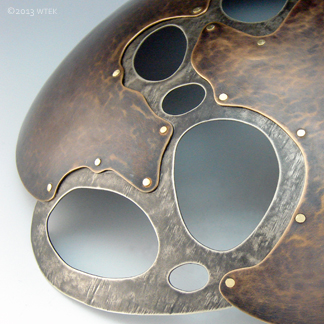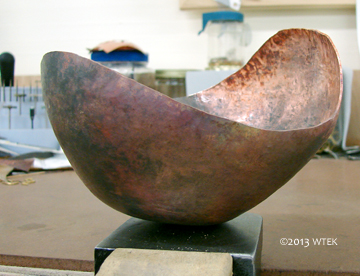
I used to want my work to be clean and precise. No scratches, symmetrical, smooth, geometric(ish). Then I started foldforming and freed myself. I began to embrace elements of wabi-sabi.
Wabi-sabi represents a comprehensive Japanese world view or aesthetic centered on the acceptance of transience and imperfection. The aesthetic is sometimes described as one of beauty that is “imperfect, impermanent, and incomplete”. – from Wikipedia
I began to revel in roughness, relish dirty, dark metal. I strove to design work that was balanced, but asymmetrical. This now defines my work.

What I didn’t become was sloppy. Each scratch, bump, or wonky line is there because I chose to keep it. I still file and sand my work. Planishing my formed bowls is the most important step.
Wabi-sabi isn’t about leaving things sloppy, not finishing properly, and using inexperience as an excuse for laziness. The beauty of imperfection is realizing that a human can’t reach the ideal. It doesn’t mean we shouldn’t strive to be better. The journey is the important part.


The difference is in the intent, isn’t it, Wendy – to strive for beauty and balance, but to preserve and honor the joy of the journey by setting an impossible goal of perfection. Lovely post. Thank you.
LikeLike
Exactly, Paula!
LikeLike
Thank you for the introduction to this, to me anyway, unknown Japanese concept/mindset. Always a joy to share your journey, thank you for influencing mine.
LikeLike
Thank you! There are so many different ways of thinking out there. It’s interesting when you find ones that resonate with you.
LikeLike
Interestingly a friend was reading a book on wabi-sabi last fall and recommended I read it. Small world
LikeLike
The Wiki article mentioned a book about wabi-sabi in art. Maybe it’s something I should read up on too.
LikeLike
Now I know the name for the aesthetic I love. It’s an honorable journey to strive for perfection, but, frankly, it’s kinda boring. Give me that fold-formed, patinaed, organic grunge metal anytime…it’s beautiful!!
LikeLike
I love it! “Grunge Metal”
LikeLike